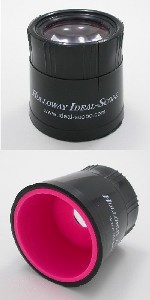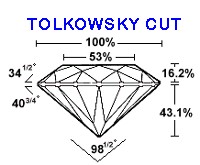Garry Holloway
In 1984, Australian jeweler, Garry Holloway studied diamond cut using a tool called the Firescope. Invented in Japan, the Firescope has a disk of red plastic surrounding a clear plastic platform that a diamond sits in while being viewed through a 10X lens from above and a light source below. The visual image of red light refracted and reflected back provides an indication of the diamond’s light return.
 Holloway went on to develop a smaller hand held device that uses the same principal and markets that tool as the Ideal-Scope. The intensity of red (returned light) and the amount of white (light leakage) is an indicator of the diamond’s light return when viewed from the top.
Holloway went on to develop a smaller hand held device that uses the same principal and markets that tool as the Ideal-Scope. The intensity of red (returned light) and the amount of white (light leakage) is an indicator of the diamond’s light return when viewed from the top.
Ideal Scope Pattern
The black pattern in the image results from the darkness caused by the observer (head or camera) that blocks an approximately 24-degree angle of light from above the diamond. The pattern of blackness defines the visual symmetry of the diamond and provides an indication of the symmetry and scintillation of the diamond.
 Holloway discovered a narrow range of diamonds that matched the Tolkowsky ideal cut’s (TIC) beauty. The most brilliant diamonds, according to his research, had shallower crowns and slightly deeper pavilions than ideal cuts. He called these Brilliant Ideal Cut (BIC) Diamonds. Those with the most fire (prism effect) have steeper crowns and slightly shallower pavilions than ideal cuts. He called these cut specifications Firey Ideal Cuts (FIC).
Holloway discovered a narrow range of diamonds that matched the Tolkowsky ideal cut’s (TIC) beauty. The most brilliant diamonds, according to his research, had shallower crowns and slightly deeper pavilions than ideal cuts. He called these Brilliant Ideal Cut (BIC) Diamonds. Those with the most fire (prism effect) have steeper crowns and slightly shallower pavilions than ideal cuts. He called these cut specifications Firey Ideal Cuts (FIC).
 While BIC diamonds are brighter than ideal cuts when viewed through a Firescope, they have less fire. Diamond cut experts know that diamonds with steeper crown angles have more fire but less brilliance because steep crowns cause light to leak out the back. Using the Firescope, Holloway discovered that reducing the pavilion angle by a small percentage improves brilliance. Holloway’s research included getting the perceptions of consumers. He found that diamond shoppers were equally impressed with BICs, FICs and ideal cuts that meant that there is a broader range of proportions that produce beautiful diamonds than established with a Tolkowsky set of proportions.
While BIC diamonds are brighter than ideal cuts when viewed through a Firescope, they have less fire. Diamond cut experts know that diamonds with steeper crown angles have more fire but less brilliance because steep crowns cause light to leak out the back. Using the Firescope, Holloway discovered that reducing the pavilion angle by a small percentage improves brilliance. Holloway’s research included getting the perceptions of consumers. He found that diamond shoppers were equally impressed with BICs, FICs and ideal cuts that meant that there is a broader range of proportions that produce beautiful diamonds than established with a Tolkowsky set of proportions.
Because diamond cutters strive to maximize the yield from each piece of rough, diamonds are often cut with steep crowns and deep pavilions (called “steep-and-deep”). Viewing these steep-and-deep diamonds with a Firescope or Ideal-Scope reveals light leaking out the pavilion and thus the loss of brilliance.
Holloway developed a theory that small variations in pavilion angles could be compensated for by cutting a larger inverse variation in crown angles. He proposed that diamonds cut with this “inverse relationship” of crown and pavilion angles could produce diamonds with beauty on par with the Tolkowsky cut design.
Cut Adviser
Garry Holloway has developed a cut grade system, the Holloway Cut Adviser (HCA), for predicting the beauty and desirability of round brilliant diamonds based on their proportions. Like most cut grade systems, Garry Holloway continues to refine and enhance his system. The current HCA defines beauty in terms of light return (brilliance), fire, and scintillation. A fourth factor, spread, relates to the diamond’s millimeter size relative to weight. This is a significant “desirability” consideration for consumers.
The Holloway Cut Adviser projects the visual appearance using a numeric grade where smaller is better.
- 0-2 Excellent
- 2-4 Very Good
- 4-6 Good
- 6-8 Fair
- 8-10 Poor
The Holloway Cut Adviser requires inputting the following diamond proportion measurements.
- Total depth percentage (depth of diamond divided by average diameter)
- Table percentage (width of table divided by average diameter)
- Crown angle (crown percentage is a less accurate surrogate)
- Pavilion angle (pavilion percentage is a less accurate surrogate)
- If pavilion percentage is used, the culet percentage is required
These cut parameters are available on recent GIA and AGS grading reports or from proportion measurement tools like the Sarin device.
The Holloway Cut Adviser is available at http://www.diamond-cut.com.au/holloway_cut_adviser.htm
The HCA software produces a numeric grade for each of the following factors:
- Light Return
- Fire
- Scintillation
- Spread
- Total Visual Performance
When the total HCA score is less than 2.0, HCA identifies them as a specific Ideal Cut based on the following crown angle parameters.
- BIC (Brilliant Ideal Cut) when crown angle is less than 32.5 degrees
- TIC (Tolkowsky Ideal Cut) when crown angle is between 32.5 and 35.5 degrees
- FIC (Firey Ideal Cut) when crown angle is more than 35.5 degrees
Advantages of HCA
The Holloway Cut Adviser is a useful tool to help select between several similar diamonds based on proportions when the diamonds are not available for actual visual comparison. With the abundance of diamonds available from online retailers, the HCA becomes a useful tool for prioritizing your list of options.
The AGS Cut Grade System requires the diamond be analyzed in proprietary equipment to determine the cut grade. This means an AGS cut grade cannot be determined for diamonds sent to GIA or other laboratories. The HCA has the advantage of being simple and it can be applied to diamonds regardless of grading laboratory as long as the four cut parameters are available.
Disadvantages of HCA
The HCA assumes a symmetrical diamond with a medium girdle and very good polish. The HCA system does not make it obvious to the user how fluctuations in girdle, polish and symmetry affect the visual performance of the diamond.
The HCA relies on mathematical averages for the four physical characteristics of the diamond. The actual parameters can be tight ranges around that average or could be broader ranges. Diamonds with a broader range of parameters can have significantly different visual performance. Not only do the results depend on averages, measurement devices can also vary in accuracy. If you compare two diamonds, the differences in calibration can influence the relative HCA results.
There are 57 facets, not just the four parameters in the HCA, that impact the movement of light through a round diamond. The new GIA Cut Grade System requires input of six proportion measurements plus girdle, culet, polish and symmetry. We are speculating that Garry Holloway is looking at these additional factors too as he continues to work on his system development.
The HCA only works for round brilliant diamonds. This is a weakness of proportion based cut grade systems (HCA, GIA, EGL, etc.) because it is very difficult to development a reliable system for fancy shaped diamonds (princess, cushions, ovals, radiants, emeralds, etc.).
